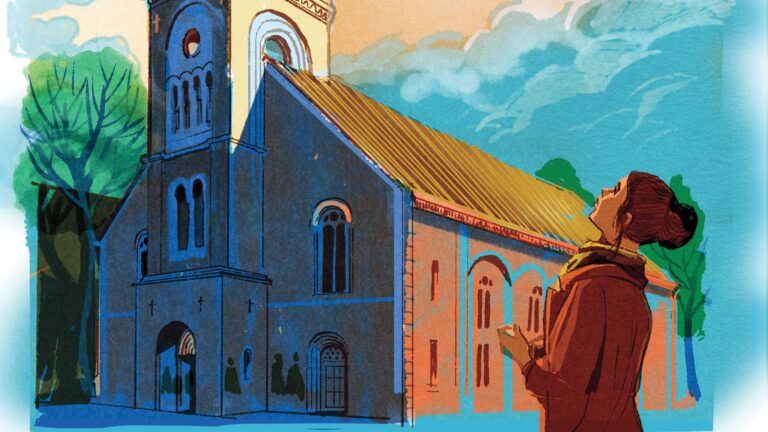With a weary sigh, I put the finishing touches on the dining room centerpiece, a wicker cornucopia overflowing with plump mini-pumpkins and lumpy gourds, resting on a bed of bittersweet branches with bright orange-yellow berries.
As I move around the table placing a foil-wrapped chocolate turkey at each place setting, a familiar sadness washes over me. It’s been years since my mom passed away, and now, with the approaching holidays I’m feeling blue once again. I shouldn’t be surprised. It happens every year at this time.
In the living room, I glumly fill glass bowls with assorted nuts and candy corn. And that’s when I see my favorite bibelot, a winsome ceramic figure of a smiling, kimono-clad Asian boy. Broken.
His right sleeve hangs loose and empty, and his little fist rests on the coffee table, still clutching his slender bamboo pole and tiny lantern. Along with Mom’s love of “oriental décor” (Translation: knick-knacks), I had inherited the little fellow from her.
With his barefoot purposeful stride and cheery cherubic countenance, he had been her favorite, too. At Christmastime, she liked to tuck a sprig of holly in his lantern; in springtime, pink cherry blossoms.
Gently, I gather up his small broken body and carry it to the kitchen table to repair. Alas, I am no expert when it comes to repairing ceramics, but with my trusty tube of superglue, I try my best. I spread the pieces out on a clean dishtowel and examine them carefully.
Broken at the wrist, the figurine’s chubby fist is pierced with a hole designed to carry the weight of his pole and lantern. Thankfully, it’s a clean break.
I line up the tiny broken hand with the green-glazed kimono-sleeve, and apply a thin layer of glue to both surfaces. Then I press the two pieces together and hold, according to instructions, for five minutes.
As the kitchen timer ticks away the seconds, I close my eyes and my thoughts drift from the task at hand to the ancient Japanese art of Kintsugi.
Dating back to the 15th century, kintsugi or “golden joinery” is the art of repairing cracked or broken ceramics with pure gold with the purpose of showing how something broken and fixed can be more beautiful and stronger than the original.
In kintsugi, the shining golden cracks, unashamedly illuminating and exposing the damage, are the aesthetic focal point. Perfect in their imperfection, golden-veined kintsugi pieces are not only more beautiful and stronger than the original unbroken pieces, they are more valuable.
What a lovely idea, I think, that beauty and strength can be revealed in brokenness.
In the Bible, human beings are referred to as “earthen vessels,” and God as our “Master Potter.” Is it possible, I wonder, that beauty and strength might be hiding, waiting to be revealed in our brokenness, too?
For example, I’ve often wondered why, when Jesus appeared to his disciples after his resurrection, his new, heavenly body was not “perfect,” but still bore the marks of the wounds suffered on the cross.
Could it be that, it is through the marks of Christ’s brokenness that his strength, beauty and power are most fully revealed?
And what about our invisible brokenness? I wonder. Our everyday silent concerns and struggles? Is it possible that beauty and strength might be hiding, waiting to be revealed in them, too?
If we’re honest, we are all broken, we all struggle. When we unashamedly confess and shine the light on our brokenness, when we share our stories, we not only open ourselves to God’s healing touch, we also sometimes we help others.
I learned this first-hand through my mom, with whom–truth be told–I didn’t always enjoy the closest relationship. When at age 78, with failing eyesight, she unexpectedly came to live in the in-law apartment attached to our house, I wasn’t so sure it would work out.
We were different in so many ways. Over the years, there were so many unresolved hurts and misunderstandings. But God, the Master Potter, knew what he was doing.
Over the next twelve years, Mom and I had the opportunity to grow to understand, respect and love each other in a way I once would never have dreamed possible.
Maybe, I think, there’s something beautiful in my holiday blues. Maybe my missing Mom is a gift–God’s way of reminding me how he can take life’s most difficult circumstances and mistakes–whatever they may be–and transform them into something beautiful and good…
The timer rings. I open my eyes and look down at the ceramic figure held tightly between my hands. For a moment, I don’t want to let go. When I do, much to my relief the little fellow’s hand stays firmly attached. But is the bond strong enough to hold his pole and lantern?
Carefully, I slide the slender bamboo stick into his tiny fist…. Success!
I return him to his place of honor on the coffee table. If I look closely, a hairline crack encircles his wrist. Like a kintsugi bracelet, I think. His tiny lantern swings gently… invitingly.
Impulsively, with a suddenly hopeful heart, I race into the dining room and break off a tiny cluster of bittersweet berries—and gently tuck them into his lantern.
Download your FREE ebook, Rediscover the Power of Positive Thinking, with Norman Vincent Peale






